Exploring the Potential of Using Waste Clay Brick Powder in Geopolymer Applications: A Comprehensive Review
Abstract
:1. Introduction
2. Methodology
3. Characterizing WCBP as a Precursor in Geopolymer Binder
3.1. Source, Treatment, and Particle Size Analysis of WCBP
3.2. Chemical Composition
3.3. X-ray Diffraction and Rietveld Analysis
| Research Reference | Brick Powder Source | Mechanical and Thermal Treatment | Median Particle Size | Characterization Techniques | Mechanical Properties | Curing Condition | Other Precursors Used in the Study | |||||
|---|---|---|---|---|---|---|---|---|---|---|---|---|
| XRD | XRF | SEM-EDS | FTIR | TGA | Compressive Strength | Flexural Strength | ||||||
| Cong et al. [44] | CDW, China | Crushing and grinding | - | + | + | + | + | + | 7 and 28 days | - | Heat curing (50, 75, and 100 °C), ambient | CCR, SF |
| Migunthanna et al. [5,29] | CDW, Australia | Oven-dried at 100 °C for 48 h and then grinding | 46 µm | + | + | + | + | - | 1, 3, 5, 7, 14, 28, 60, and 90 days | - | Ambient | FA, GGBFS |
| Vafaei et al. [69,70] | Red clay brick | Crushing and grinding | Less than 70 µm | + | + | + | + | - | 28 days | - | Heat curing (95 °C) for 20 h, ambient | PHS |
| Guo et al. [61] | CDW, China | - | - | + | + | + | + | - | 7 and 28 days | - | Ambient | FA |
| Wong et al. [71] | CDW | Crushing and grinding | - | + | + | + | - | - | 1 and 28 days | - | Ambient | FA |
| Mahmoodi et al. [32,33,34,35,72] | CDW, Canada | Grinding | Less than 75 µm | + | + | + | + | - | 7 and 28 days | - | Heat curing (50, 75, and 100 °C), ambient | RCT, RWT, RCW, MK, GGBFS, FA |
| Robayo-Salazar et al. [62,66] | CDW, Colombia | Grinding | 24.25 µm | + | + | + | - | - | 7 and 28 days | - | Heat curing (70 °C) for 24 h, ambient | OPC |
| Ouda et al. [48] | CDW, Egypt | Crushing and grinding | davg = 90 µm | + | - | + | + | + | 1, 7, 14, and 28 days | - | Heat curing (80 °C) for 24 h | DCP |
| Rovnaník et al. [54,55] | Waste hollow red clay brick | Grinding | 8.5 µm | + | + | + | + | - | 7, 14, 28, and 90 days | 7, 14, 28, and 90 days | Heat curing (40 °C), ambient | MK, FA |
| Tuyan et al. [27] | Waste clay brick powder, Izmir | - | davg = 100 µm | + | + | + | + | + | 1, 3, 5, 7, 28, and 90 days | - | Heat curing (80 and 90 °C), ambient | |
| Sassoni et al. [73] | Brick waste | Grinding | davg = 10 µm | + | + | + | - | - | 7, 28, and 90 days | 7, 28, and 90 days | Heat curing (50 °C), ambient | - |
| Fort et al. [24,25,26] | Waste brick, Czech Republic | Crushing, grinding, and oven-dried at 80 °C for 24 h | 50 µm | + | + | + | - | + | 28 days | - | Heat curing (60 and 80 °C), ambient | GGBFS |
| Pasupathy et al. [3,43] | Waste brick, Australia | Oven-dried at 105 °C for 24 h and then grinding | 20.5 µm | + | + | + | + | - | 7 and 28 days | - | Heat curing (60 °C) for 24 h | FA, GGBFS |
| Ahmed et al. [48,57,67,74] | Hollow clay brick, Baghdad | Crushing and grinding | - | - | + | - | - | 7 and 28 days | 7 and 28 days | Heat curing (50, 60, 70, 80, and 100 °C), ambient | MK | |
| Al-Noaimat et al. [58] | End-of-life brick, London | Crushing and grinding | Less than 125 µm | + | + | + | - | - | 3 days | 3 days | Heat curing (60 °C) for 24 h | FA |
| Alzeebaree et al. [46] | Clay brick, Iraq | Crushing and grinding | Less than 300 µm | + | + | + | - | - | 28, 56, 90, and 120 days | - | Heat curing (45 °C) for 24 h | Glass powder, Fine soil |
| Bumanis et al. [51] | Waste red brick | Grinding | 24.64 µm | + | + | + | + | + | 1, 28, and 35 days | - | Silica gel, Clay | |
| Kul et al. [75] | CDW | Crushing and grinding | 8.5 µm | + | + | + | - | - | - | - | Heat curing | RT |
| Yehualaw et al. [56] | Waste brick powder | - | 10.32 µm | + | + | + | + | - | 3, 7, and 28 days | - | Ambient | GGBFS |
| Dang et al. [76] | Masonry waste | Grinding | - | - | + | - | - | - | 7, 28 days | 7 and 28 days | Ambient | GGBFS |
| D’Angelo et al. [63] | CDW, Italy | Grinding | Less than 0.125 mm | + | + | + | + | + | 28 days | 28 days | Heat curing (60 °C) for 3D | |
| Li et al. [64] | Waste brick | Grinding | 4.34 µm | + | + | + | - | + | 7, 28, and 90 days | 7, 28, and 90 days | Heat curing (70 °C) for 3D | |
| Liu et al. [77] | CDW treatment plant | Oven-dried at 105 °C for 24 h and grinding | Less than 0.075 mm | + | - | + | + | + | 3, 7, and 28 days | - | Steam curing (80 °C), ambient | SS, FA |
| Liang et al. [52] | Waste red brick | Oven-dried at 80 °C and Grinding | 4.7 µm | + | + | + | + | + | 7 and 28 days | - | Ambient | GGBFS, FA |
| Hwang et al. [59] | CDW, Taiwan | Grinding | 10.32 µm | + | + | + | + | - | 3, 7, 28, and 56 days | - | Ambient | WCP, GGBFS, FA |
| Silva et al. [38,39] | Fired clay brick | Crushing and grinding | 7.39 µm | + | + | + | + | - | 7 days | - | Heat curing (65, 80, and 90 °C) for 1,3,7 D, ambient | |
| Tazune et al. [78] | Fired clay brick | Grinding | 125 µm | + | + | + | + | 28 days | - | Ambient | MK, RHA | |
| Shen et al. [36] | Waste brick | Grinding | - | + | + | + | + | + | 3 days | - | Heat curing (70 °C) for 3D | |
| Kaze Rodrigue et al. [79] | Waste Fired clay brick | Oven-dried for 48 h and grinding | Less than 80 µm | + | + | + | - | - | - | - | Ambient | Volcanic scoria (Zg) |
| Rakhimova et al. [80] | CDW | - | - | - | - | - | - | 1, 3, and 7 days | - | Ambient and steam curing | GGBFS | |
| Sharmin et al. [4] | Brick pellets, Australia | Oven-dried at 105 °C for 24 h and grinding | 11.91 µm | + | + | + | - | - | 7, 28, 56, and 90 days | - | Heat curing (40 and 60 °C) for 10 h, ambient | GGBFS, FA |
4. Fresh Properties, Strength, and Microstructure of WCBP-Based Geopolymers
4.1. Effect of WCBP on Setting Time
4.2. Effect of WCBP on Workability
4.3. Effect of Curing, Activators, and Additives on Compressive Strength
4.4. Microstructural Properties of WCBP-Based Geopolymers
5. Durability Related Properties of WCBP-Based Geopolymers
5.1. Effect of Precursors and Curing on Water Absorption of WCBP-Based Geopolymers
5.2. Effect of WCBP on Other Durability Properties
6. Environmental Impact Analysis of WCBP-Based Geopolymers
7. Conclusions and Recommendations
- Further research is needed to optimize mix designs for WCBP-based geopolymers, aiming to achieve desired properties, minimize raw material usage, and reduce environmental impact, including the production of WCBP-only geopolymers;
- Comprehensive studies are needed to assess the mechanical and microstructural properties and durability of WCBP-based geopolymers. Research should investigate the long-term performance of these materials under various environmental conditions, including exposure to moisture, temperature variations, and chemical agents, to ensure their suitability for different applications especially for ambient cured geopolymers;
- More research is required to develop simplified geopolymers based on WCBP precursors, akin to conventional cement. Investigating one-part geopolymer methods could lead to the development of simplified geopolymers that are easier to produce and use in various applications;
- There is a need for further exploration of activators alternative to NaOH. Research should focus on identifying sustainable activators with comparable performance to NaOH but lower environmental impact;
- Exploration of new applications for WCBP-based geopolymers beyond construction materials is necessary. Research could focus on potential uses in areas such as waste management, soil stabilization, or alternative building materials to expand the range of sustainable solutions offered by WCBP geopolymers.
Author Contributions
Funding
Data Availability Statement
Conflicts of Interest
References
- Tang, Q.; Ma, Z.; Wu, H.; Wang, W. The Utilization of Eco-Friendly Recycled Powder from Concrete and Brick Waste in New Concrete: A Critical Review. Cem. Concr. Compos. 2020, 114, 103807. [Google Scholar] [CrossRef]
- Wu, H.; Zuo, J.; Zillante, G.; Wang, J.; Yuan, H. Construction and Demolition Waste Research: A Bibliometric Analysis. Archit. Sci. Rev. 2019, 62, 354–365. [Google Scholar] [CrossRef]
- Pasupathy, K.; Ramakrishnan, S.; Sanjayan, J. Formulating Eco-Friendly Geopolymer Foam Concrete by Alkali-Activation of Ground Brick Waste. J. Clean. Prod. 2021, 325, 129180. [Google Scholar] [CrossRef]
- Sharmin, S.; Sarker, P.K.; Biswas, W.K.; Abousnina, R.M.; Javed, U. Characterization of Waste Clay Brick Powder and Its Effect on the Mechanical Properties and Microstructure of Geopolymer Mortar. Constr. Build. Mater. 2024, 412, 134848. [Google Scholar] [CrossRef]
- Migunthanna, J.; Rajeev, P.; Sanjayan, J. Investigation of Waste Clay Brick as Partial Replacement of Geopolymer Binders for Rigid Pavement Application. Constr. Build. Mater. 2021, 305, 124787. [Google Scholar] [CrossRef]
- Sharmin, S.; Biswas, W.K.; Sarker, P.K. Evaluating Techno-Eco-Efficiency of Waste Clay Brick Powder in Geopolymer Binder. Preprints 2024, 14, 692. [Google Scholar] [CrossRef]
- Adamson, M.; Razmjoo, A.; Poursaee, A. Durability of Concrete Incorporating Crushed Brick as Coarse Aggregate. Constr. Build. Mater. 2015, 94, 426–432. [Google Scholar] [CrossRef]
- Khalaf, F.M. Using Crushed Clay Brick as Coarse Aggregate in Concrete. J. Mater. Civ. Eng. 2006, 18, 518–526. [Google Scholar] [CrossRef]
- Debieb, F.; Kenai, S. The Use of Coarse and Fine Crushed Bricks as Aggregate in Concrete. Constr. Build. Mater. 2008, 22, 886–893. [Google Scholar] [CrossRef]
- Klak, F.S.; Saleh, H.; Tais, A.S. Recycling of Crushed Clay Bricks as Fine Aggregate in Concrete and Cement Mortar. Aust. J. Struct. Eng. 2023, 24, 67–76. [Google Scholar] [CrossRef]
- Silva, F.A.N.; Delgado, J.M.P.Q.; Azevedo, A.C.; Lima, A.G.B.; Vieira, C.S. Preliminary Analysis of the Use of Construction Waste to Replace Conventional Aggregates in Concrete. Buildings 2021, 11, 81. [Google Scholar] [CrossRef]
- Khalaf, F.M.; Devenny, A.S. Recycling of Demolished Masonry Rubble as Coarse Aggregate in Concrete: Review. J. Mater. Civ. Eng. 2004, 16, 331–340. [Google Scholar] [CrossRef]
- Zhao, Y.; Gao, J.; Chen, F.; Liu, C.; Chen, X. Utilization of Waste Clay Bricks as Coarse and Fine Aggregates for the Preparation of Lightweight Aggregate Concrete. J. Clean. Prod. 2018, 201, 706–715. [Google Scholar] [CrossRef]
- Yang, J.; Du, Q.; Bao, Y. Concrete with Recycled Concrete Aggregate and Crushed Clay Bricks. Constr. Build. Mater. 2011, 25, 1935–1945. [Google Scholar] [CrossRef]
- Cachim, P.B. Mechanical Properties of Brick Aggregate Concrete. Constr. Build. Mater. 2009, 23, 1292–1297. [Google Scholar] [CrossRef]
- Schackow, A.; Stringari, D.; Senff, L.; Correia, S.L.; Segadães, A.M. Influence of Fired Clay Brick Waste Additions on the Durability of Mortars. Cem. Concr. Compos. 2015, 62, 82–89. [Google Scholar] [CrossRef]
- Liu, Q.; Tong, T.; Liu, S.; Yang, D.; Yu, Q. Investigation of Using Hybrid Recycled Powder from Demolished Concrete Solids and Clay Bricks as a Pozzolanic Supplement for Cement. Constr. Build. Mater. 2014, 73, 754–763. [Google Scholar] [CrossRef]
- Vieira, T.; Alves, A.; de Brito, J.; Correia, J.R.; Silva, R.V. Durability-Related Performance of Concrete Containing Fine Recycled Aggregates from Crushed Bricks and Sanitary Ware. Mater. Des. 2016, 90, 767–776. [Google Scholar] [CrossRef]
- Afshinnia, K.; Poursaee, A. The Potential of Ground Clay Brick to Mitigate Alkali-Silica Reaction in Mortar Prepared with Highly Reactive Aggregate. Constr. Build. Mater. 2015, 95, 164–170. [Google Scholar] [CrossRef]
- Naceri, A.; Hamina, M.C. Use of Waste Brick as a Partial Replacement of Cement in Mortar. Waste Manag. 2009, 29, 2378–2384. [Google Scholar] [CrossRef]
- Bektas, F.; Wang, K.; Ceylan, H. Effects of Crushed Clay Brick Aggregate on Mortar Durability. Constr. Build. Mater. 2009, 23, 1909–1914. [Google Scholar] [CrossRef]
- Böke, H.; Akkurt, S.; Ipekoǧlu, B.; Uǧurlu, E. Characteristics of Brick Used as Aggregate in Historic Brick-Lime Mortars and Plasters. Cem. Concr. Res. 2006, 36, 1115–1122. [Google Scholar] [CrossRef]
- Ge, Z.; Wang, Y.; Sun, R.; Wu, X.; Guan, Y. Influence of Ground Waste Clay Brick on Properties of Fresh and Hardened Concrete. Constr. Build. Mater. 2015, 98, 128–136. [Google Scholar] [CrossRef]
- Fořt, J.; Mildner, M.; Keppert, M.; Pommer, V.; Černý, R. Experimental and Environmental Analysis of High-Strength Geopolymer Based on Waste Bricks and Blast Furnace Slag. Polymers 2023, 15, 3092. [Google Scholar] [CrossRef] [PubMed]
- Fořt, J.; Vejmelková, E.; Koňáková, D.; Alblová, N.; Čáchová, M.; Keppert, M.; Rovnaníková, P.; Černý, R. Application of Waste Brick Powder in Alkali Activated Aluminosilicates: Functional and Environmental Aspects. J. Clean. Prod. 2018, 194, 714–725. [Google Scholar] [CrossRef]
- Fořt, J.; Novotný, R.; Vejmelková, E.; Trník, A.; Rovnaníková, P.; Keppert, M.; Pommer, V.; Černý, R. Characterization of Geopolymers Prepared Using Powdered Brick. J. Mater. Res. Technol. 2019, 8, 6253–6261. [Google Scholar] [CrossRef]
- Tuyan, M.; Andiç-Çakir, Ö.; Ramyar, K. Effect of Alkali Activator Concentration and Curing Condition on Strength and Microstructure of Waste Clay Brick Powder-Based Geopolymer. Compos. B Eng. 2018, 135, 242–252. [Google Scholar] [CrossRef]
- Migunthanna, J.; Rajeev, P.; Sanjayan, J. Shrinkage Model for Waste Clay Brick-Based Geopolymer Concrete. Constr. Build. Mater. 2023, 404, 133196. [Google Scholar] [CrossRef]
- Migunthanna, J.; Rajeev, P.; Sanjayan, J. Investigation of Waste Clay Brick as Partial Replacement in Geopolymer Binder. Constr. Build. Mater. 2023, 365, 130107. [Google Scholar] [CrossRef]
- Migunthanna, J.; Rajeev, P.; Sanjayan, J. Waste Clay Brick as a Part Binder for Pavement Grade Geopolymer Concrete. Int. J. Pavement Res. Technol. 2023, 1, 1–18. [Google Scholar] [CrossRef]
- Migunthanna, J.; Manjunatha, N.T.; Shatagar, V.G.; Raghu, D.H.; Zinzala, R.S.; Rajeev, P.; Sanjayan, J. Simplified Life Cycle Analysis for Rigid Pavements Constructed Using Waste Materials as Binders in Concrete. Int. J. Stud. Proj. Report. 2022, 1, 143–165. [Google Scholar] [CrossRef]
- Mahmoodi, O.; Siad, H.; Lachemi, M.; Sahmaran, M. Synthesis and Optimization of Binary Systems of Brick and Concrete Wastes Geopolymers at Ambient Environment. Constr. Build. Mater. 2021, 276, 122217. [Google Scholar] [CrossRef]
- Mahmoodi, O.; Siad, H.; Lachemi, M.; Dadsetan, S.; Sahmaran, M. Development and Characterization of Binary Recycled Ceramic Tile and Brick Wastes-Based Geopolymers at Ambient and High Temperatures. Constr. Build. Mater. 2021, 301, 124138. [Google Scholar] [CrossRef]
- Mahmoodi, O.; Siad, H.; Lachemi, M.; Dadsetan, S.; Şahmaran, M. Optimized Application of Ternary Brick, Ceramic and Concrete Wastes in Sustainable High Strength Geopolymers. J. Clean. Prod. 2022, 338, 130650. [Google Scholar] [CrossRef]
- Dadsetan, S.; Siad, H.; Lachemi, M.; Mahmoodi, O.; Sahmaran, M. Development of Ambient Cured Geopolymer Binders Based on Brick Waste and Processed Glass Waste. Environ. Sci. Pollut. Res. 2022, 29, 80755–80774. [Google Scholar] [CrossRef] [PubMed]
- Shen, J.; Li, Y.; Lin, H.; Lv, J.; Feng, S.; Ci, J. Early Properties and Chemical Structure Analysis of Alkali-Activated Brick Geopolymer with Varied Alkali Dosage. J. Build. Eng. 2022, 60, 105186. [Google Scholar] [CrossRef]
- Shen, J.; Li, Y.; Lin, H.; Lv, J.; Feng, S.; Ci, J. Early Properties and Microstructure Evolution of Alkali-Activated Brick Powder Geopolymers at Varied Curing Humidity. J. Build. Eng. 2022, 54, 104674. [Google Scholar] [CrossRef]
- Silva, G.; Kim, S.; Castañeda, A.; Donayre, R.; Nakamatsu, J.; Aguilar, R.; Korniejenko, K.; Łach, M.; Mikuła, J. A Comparative Study of Linen (Flax) Fibers as Reinforcement of Fly Ash and Clay Brick Powder Based Geopolymers. In Proceedings of the 7th International Conference on Advanced Materials and Structures-AMS, Timisoara, Romania, 28–31 March 2018; Volume 416. [Google Scholar]
- Silva, G.; Castañeda, D.; Kim, S.; Castañeda, A.; Bertolotti, B.; Ortega-San-Martin, L.; Nakamatsu, J.; Aguilar, R. Analysis of the Production Conditions of Geopolymer Matrices from Natural Pozzolana and Fired Clay Brick Wastes. Constr. Build. Mater. 2019, 215, 633–643. [Google Scholar] [CrossRef]
- Dadsetan, S.; Siad, H.; Lachemi, M.; Sahmaran, M. Construction and Demolition Waste in Geopolymer Concrete Technology: A Review. Mag. Concr. Res. 2019, 71, 1232–1252. [Google Scholar] [CrossRef]
- Ye, T.; Xiao, J.; Duan, Z.; Li, S. Geopolymers Made of Recycled Brick and Concrete Powder—A Critical Review. Constr. Build. Mater. 2022, 330, 127232. [Google Scholar] [CrossRef]
- Migunthanna, J.; Rajeev, P.; Sanjayan, J. Waste Clay Bricks as a Geopolymer Binder for Pavement Construction. Sustainability 2022, 14, 6456. [Google Scholar] [CrossRef]
- Pasupathy, K.; Ramakrishnan, S.; Sanjayan, J. 3D Concrete Printing of Eco-Friendly Geopolymer Containing Brick Waste. Cem. Concr. Compos. 2023, 138, 104943. [Google Scholar] [CrossRef]
- Cong, P.; Cheng, Y.; Ge, W.; Zhang, A. Mechanical, Microstructure and Reaction Process of Calcium Carbide Slag-Waste Red Brick Powder Based Alkali-Activated Materials (CWAAMs). J. Clean. Prod. 2022, 331, 129845. [Google Scholar] [CrossRef]
- Dang, J.; Zhao, J. Influence of Waste Clay Bricks as Fine Aggregate on the Mechanical and Microstructural Properties of Concrete. Constr. Build. Mater. 2019, 228, 116757. [Google Scholar] [CrossRef]
- Alzeebaree, R.; Mawlod, A.O.; Mohammedameen, A.; Niş, A. Using of Recycled Clay Brick/Fine Soil to Produce Sodium Hydroxide Alkali Activated Mortars. Adv. Struct. Eng. 2021, 24, 2996–3009. [Google Scholar] [CrossRef]
- Liu, M.; Wang, C.; Wu, H.; Yang, D.; Ma, Z. Reusing Recycled Powder as Eco-Friendly Binder for Sustainable GGBS-Based Geopolymer Considering the Effects of Recycled Powder Type and Replacement Rate. J. Clean. Prod. 2022, 364, 132656. [Google Scholar] [CrossRef]
- Ouda, A.S.; Gharieb, M. Development the Properties of Brick Geopolymer Pastes Using Concrete Waste Incorporating Dolomite Aggregate. J. Build. Eng. 2020, 27, 100919. [Google Scholar] [CrossRef]
- Liu, M.; Yang, D.; Chen, L.; Chen, G.; Ma, Z. Effect of Silicate Modulus and Alkali Content on the Microstructure and Macroscopic Properties of Alkali-Activated Recycled Powder Mortar. Constr. Build. Mater. 2023, 397, 132365. [Google Scholar] [CrossRef]
- Komnitsas, K.; Zaharaki, D.; Vlachou, A.; Bartzas, G.; Galetakis, M. Effect of Synthesis Parameters on the Quality of Construction and Demolition Wastes (CDW) Geopolymers. Adv. Powder Technol. 2015, 26, 368–376. [Google Scholar] [CrossRef]
- Bumanis, G.; Vaičiukynienė, D. Alkali Activation of Milled Red Brick Waste and Calcined Illite Clay with Silica Gel Addition. Materials 2022, 15, 3195. [Google Scholar] [CrossRef]
- Liang, G.; Luo, L.; Yao, W. Reusing Waste Red Brick Powder as Partial Mineral Precursor in Eco-Friendly Binders: Reaction Kinetics, Microstructure and Life-Cycle Assessment. Resour. Conserv. Recycl. 2022, 185, 106523. [Google Scholar] [CrossRef]
- Murmu, A.L.; Patel, A. Towards Sustainable Bricks Production: An Overview. Constr. Build. Mater. 2018, 165, 112–125. [Google Scholar] [CrossRef]
- Rovnaník, P.; Řezník, B.; Rovnaníková, P. Blended Alkali-Activated Fly Ash/Brick Powder Materials. Proc. Procedia Eng 2016, 151, 108–113. [Google Scholar] [CrossRef]
- Rovnaník, P.; Rovnaníková, P.; Vyšvařil, M.; Grzeszczyk, S.; Janowska-Renkas, E. Rheological Properties and Microstructure of Binary Waste Red Brick Powder/Metakaolin Geopolymer. Constr. Build. Mater. 2018, 188, 924–933. [Google Scholar] [CrossRef]
- Yehualaw, M.D.; Hwang, C.L.; Vo, D.H.; Koyenga, A. Effect of Alkali Activator Concentration on Waste Brick Powder-Based Ecofriendly Mortar Cured at Ambient Temperature. J. Mater. Cycles Waste Manag. 2021, 23, 727–740. [Google Scholar] [CrossRef]
- Ahmed, J.K.; Atmaca, N.; Khoshnaw, G.J. Building a Sustainable Future: An Experimental Study on Recycled Brick Waste Powder in Engineered Geopolymer Composites. Case Stud. Constr. Mater. 2024, 20, e02863. [Google Scholar] [CrossRef]
- Al-Noaimat, Y.A.; Chougan, M.; Al-kheetan, M.J.; Yio, M.H.N.; Wong, H.S.; Ghaffar, S.H. Upcycling End-of-Life Bricks in High-Performance One-Part Alkali-Activated Materials. Dev. Built. 2023, 16, 100231. [Google Scholar] [CrossRef]
- Hwang, C.L.; Damtie Yehualaw, M.; Vo, D.H.; Huynh, T.P. Development of High-Strength Alkali-Activated Pastes Containing High Volumes of Waste Brick and Ceramic Powders. Constr. Build. Mater. 2019, 218, 519–529. [Google Scholar] [CrossRef]
- Liu, Z. LSU Digital Commons Applications of Geopolymer in Civil Engineering: Feasibility Study of Loess Stabilization and Waste Concrete Recycling; Louisiana State University and Agricultural & Mechanical College: Baton Rouge, LA, USA, 2015. [Google Scholar]
- Guo, X.; Shi, H.; Wei, X. Pore Properties, Inner Chemical Environment, and Microstructure of Nano-Modified CFA-WBP (Class C Fly Ash-Waste Brick Powder) Based Geopolymers. Cem. Concr. Compos. 2017, 79, 53–61. [Google Scholar] [CrossRef]
- Robayo-Salazar, R.A.; Rivera, J.F.; Mejía de Gutiérrez, R. Alkali-Activated Building Materials Made with Recycled Construction and Demolition Wastes. Constr. Build. Mater. 2017, 149, 130–138. [Google Scholar] [CrossRef]
- D’Angelo, G.; Fumo, M.; Del Rio Merino, M.; Capasso, I.; Campanile, A.; Iucolano, F.; Caputo, D.; Liguori, B. Crushed Bricks: Demolition Waste as a Sustainable Raw Material for Geopolymers. Sustainability 2021, 13, 7572. [Google Scholar] [CrossRef]
- Li, Y.; Shen, J.; Lin, H.; Lv, J.; Feng, S.; Ci, J. Properties and Environmental Assessment of Eco-Friendly Brick Powder Geopolymer Binders with Varied Alkali Dosage. J. Build. Eng. 2022, 58, 105020. [Google Scholar] [CrossRef]
- ASTM-C-618-98/XAB; Standard Specification for Coal Ash and Raw or Calcined Natural Pozzolan for Use in Concrete 1. ASTM International: West Conshohocken, PA, USA, 1998. [CrossRef]
- Robayo, R.A.; Mulford, A.; Munera, J.; Mejía de Gutiérrez, R. Alternative Cements Based on Alkali-Activated Red Clay Brick Waste. Constr. Build. Mater. 2016, 128, 163–169. [Google Scholar] [CrossRef]
- Ahmed, M.F.; Khalil, W.I.; Frayyeh, Q.J. Effect of Waste Clay Brick on the Modulus of Elasticity, Drying Shrinkage and Microstructure of Metakaolin-Based Geopolymer Concrete. Arab. J. Sci. Eng. 2022, 47, 12671–12683. [Google Scholar] [CrossRef]
- Hwang, C.L.; Yehualaw, M.D.; Vo, D.H.; Huynh, T.P.; Largo, A. Performance Evaluation of Alkali Activated Mortar Containing High Volume of Waste Brick Powder Blended with Ground Granulated Blast Furnace Slag Cured at Ambient Temperature. Constr. Build. Mater. 2019, 223, 657–667. [Google Scholar] [CrossRef]
- Vafaei, M.; Allahverdi, A. Strength Development and Acid Resistance of Geopolymer Based on Waste Clay Brick Powder and Phosphorous Slag. Struct. Concr. 2019, 20, 1596–1606. [Google Scholar] [CrossRef]
- Vafaei, M.; Allahverdi, A.; Dong, P.; Bassim, N.; Mahinroosta, M. Resistance of Red Clay Brick Waste/Phosphorus Slag-Based Geopolymer Mortar to Acid Solutions of Mild Concentration. J. Build. Eng. 2021, 34, 102006. [Google Scholar] [CrossRef]
- Wong, C.L.; Mo, K.H.; Alengaram, U.J.; Yap, S.P. Mechanical Strength and Permeation Properties of High Calcium Fly Ash-Based Geopolymer Containing Recycled Brick Powder. J. Build. Eng. 2020, 32, 101655. [Google Scholar] [CrossRef]
- Mahmoodi, O.; Siad, H.; Lachemi, M.; Şahmaran, M. Comparative Life Cycle Assessment Analysis of Mono, Binary and Ternary Construction and Demolition Wastes-Based Geopolymer Binders. Mater. Today Proc. 2023; in press. [Google Scholar] [CrossRef]
- Sassoni, E.; Pahlavan, P.; Franzoni, E.; Bignozzi, M.C. Valorization of Brick Waste by Alkali-Activation: A Study on the Possible Use for Masonry Repointing. Ceram. Int. 2016, 42, 14685–14694. [Google Scholar] [CrossRef]
- Ahmed, M.F. Effective Use of Waste Plastic As Sand in Metakaolin/Brick-Powder Geopolymer Concrete. Jordan J. Civ. Eng. 2023, 17, 473–485. [Google Scholar] [CrossRef]
- Kul, A.; Ozel, B.F.; Ozcelikci, E.; Gunal, M.F.; Ulugol, H.; Yildirim, G.; Sahmaran, M. Characterization and Life Cycle Assessment of Geopolymer Mortars with Masonry Units and Recycled Concrete Aggregates Assorted from Construction and Demolition Waste. J. Build. Eng. 2023, 78, 107546. [Google Scholar] [CrossRef]
- Dang, J.; Tang, X.; Xiao, J.; Duan, Z.; Han, A. Role of Recycled Brick Powder and Alkaline Solution on the Properties of Eco-Friendly Alkali-Activated Foam Concrete. J. Clean. Prod. 2023, 436, 140381. [Google Scholar] [CrossRef]
- Liu, Y.X.; Gu, F.; Zhou, H.; Li, Q.; Shang, S.Q. Study on the Performance and Reaction Mechanism of Alkali-Activated Clay Brick with Steel Slag and Fly Ash. Constr. Build. Mater. 2024, 411, 134406. [Google Scholar] [CrossRef]
- Tazune, F.K.; Tchakouté, H.K.; Rüscher, C.H.; Tchekwagep, J.J.K.; Hou, P. Effects of Fe2O3/SiO2 Molar Ratios in the Fe-Silica on the Compressive Strengths and Microstructural Properties of Geopolymer Materials Derived from Waste Fired Clay Brick and Metakaolin. J. Inorg. Organomet. Polym. Mater. 2024, 34, 1725–1737. [Google Scholar] [CrossRef]
- Kaze, C.R.; Beleuk à Moungam, L.M.; Sontia Metekong, J.V.; Alomayri, T.S.; Naghizadeh, A.; Tchadjie, L. Thermal Behaviour, Microstructural Changes and Mechanical Properties of Alkali-Activated Volcanic Scoria-Fired Waste Clay Brick Blends. Dev. Built Environ. 2023, 14, 100153. [Google Scholar] [CrossRef]
- Rakhimova, N.R. A Review of Calcined Clays and Ceramic Wastes as Sources for Alkali-Activated Materials. Geosystem Eng. 2020, 23, 287–298. [Google Scholar] [CrossRef]
- Robayo-Salazar, R.A.; Mejía-Arcila, J.M.; Mejía de Gutiérrez, R. Eco-Efficient Alkali-Activated Cement Based on Red Clay Brick Wastes Suitable for the Manufacturing of Building Materials. J. Clean. Prod. 2017, 166, 242–252. [Google Scholar] [CrossRef]
- Vasić, M.V.; Terzić, A.; Radovanović, Ž.; Radojević, Z.; Warr, L.N. Alkali-Activated Geopolymerization of a Low Illitic Raw Clay and Waste Brick Mixture. An Alternative to Traditional Ceramics. Appl. Clay Sci. 2022, 218, 106410. [Google Scholar] [CrossRef]
- Bringing Embodied Carbon Upfront. Available online: https://worldgbc.org/advancing-net-zero/embodied-carbon/ (accessed on 12 December 2023).
- Li, L.G.; Lin, Z.H.; Chen, G.M.; Kwan, A.K.H. Reutilizing Clay Brick Dust as Paste Substitution to Produce Environment-Friendly Durable Mortar. J. Clean. Prod. 2020, 274, 122787. [Google Scholar] [CrossRef]
- Mir, N.; Khan, S.A.; Kul, A.; Sahin, O.; Sahmaran, M.; Koc, M. Life Cycle Assessment of Construction and Demolition Waste-Based Geopolymers Suited for Use in 3-Dimensional Additive Manufacturing. Clean. Eng. Technol. 2022, 10, 100553. [Google Scholar] [CrossRef]

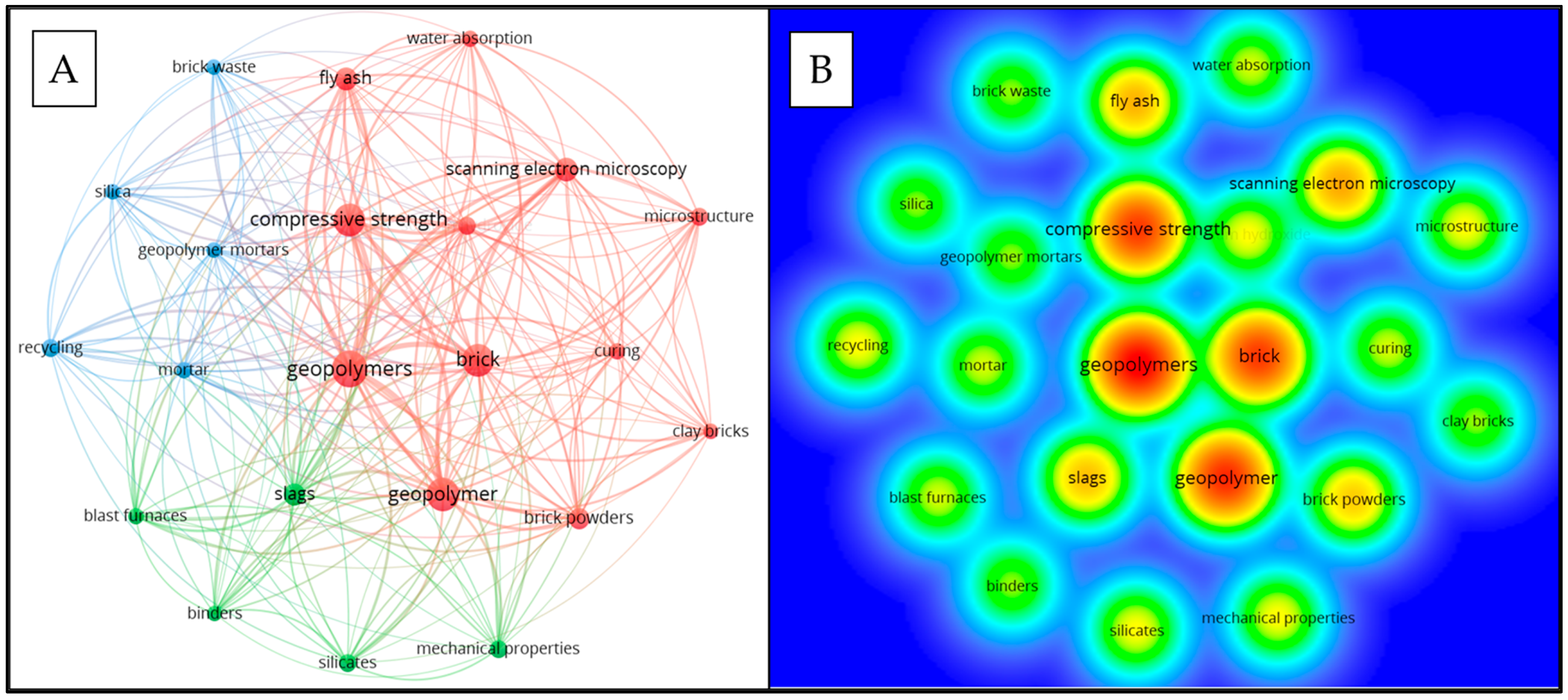
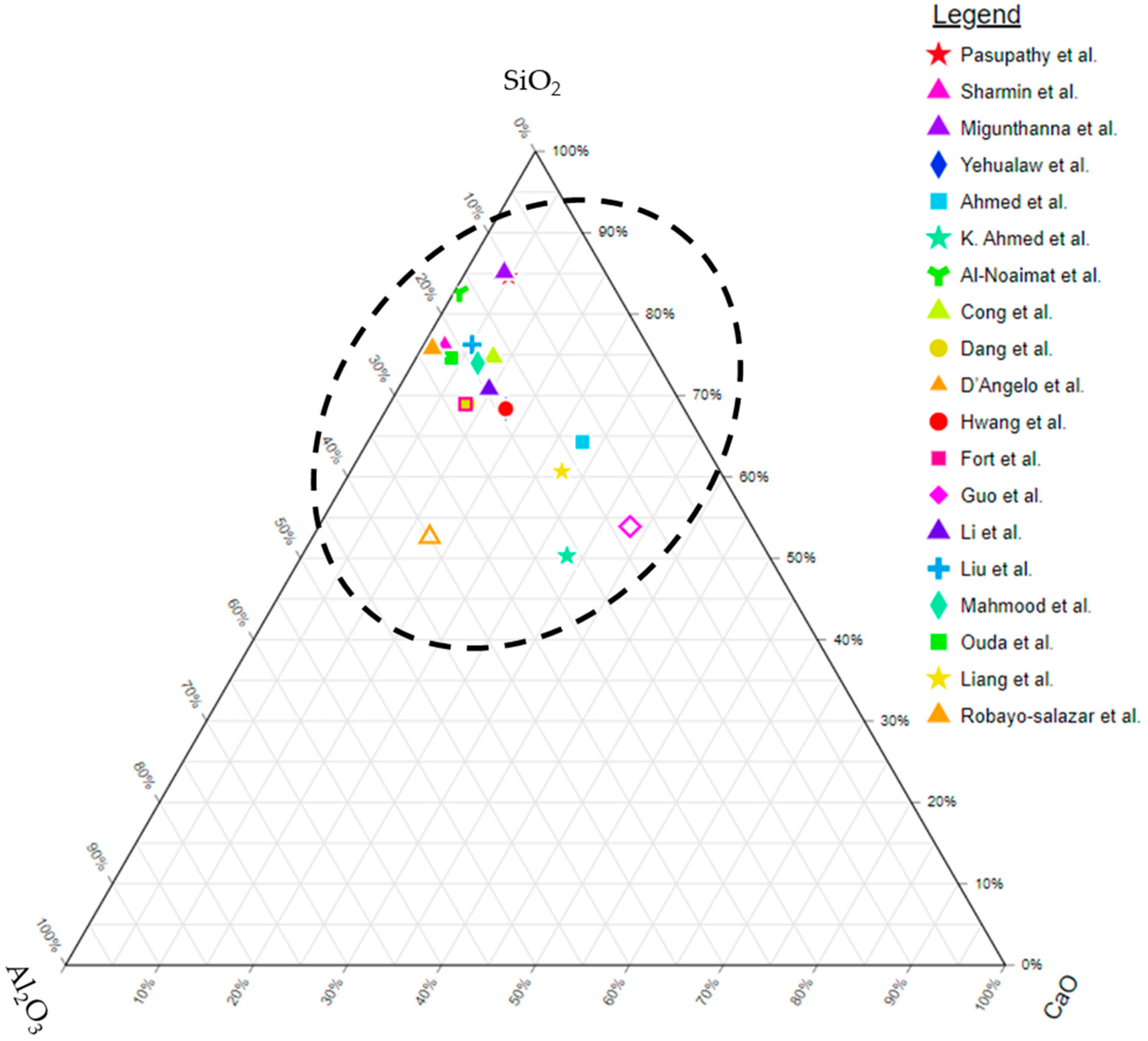
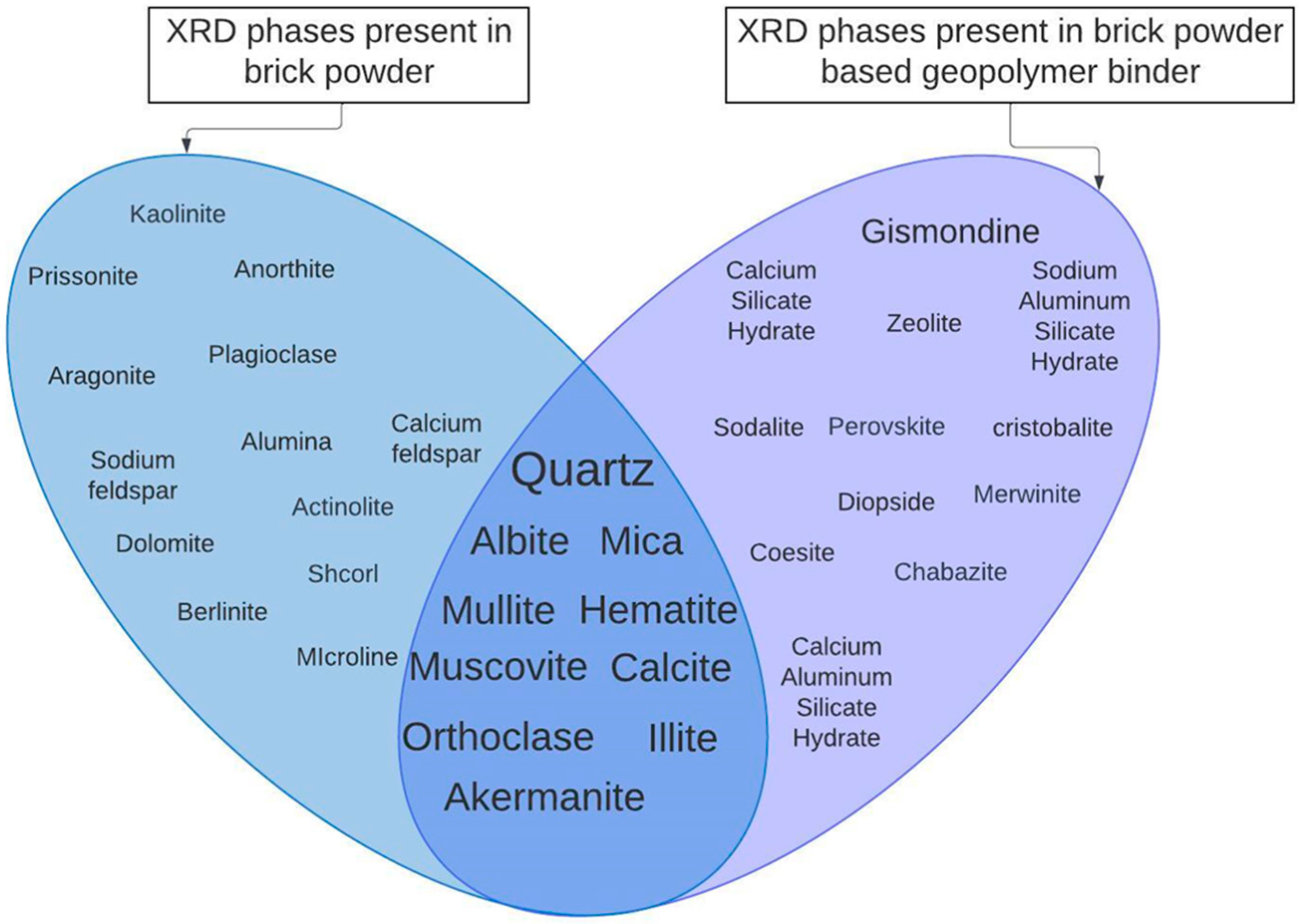
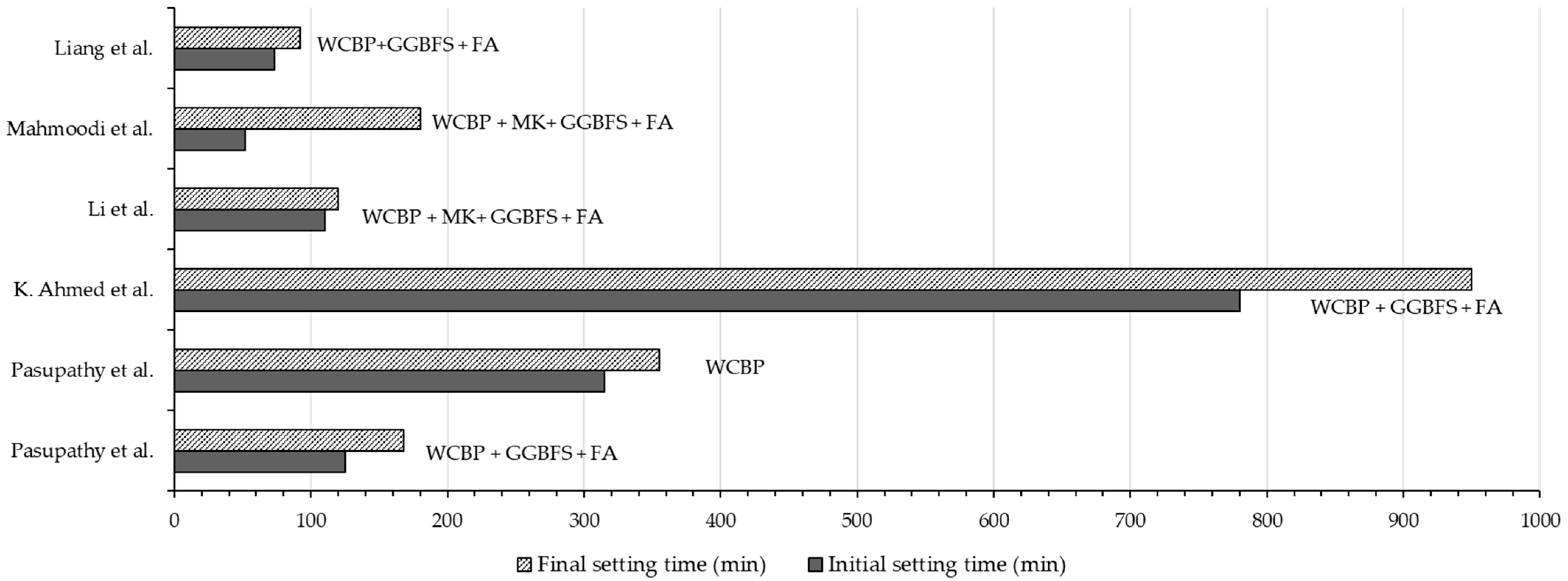
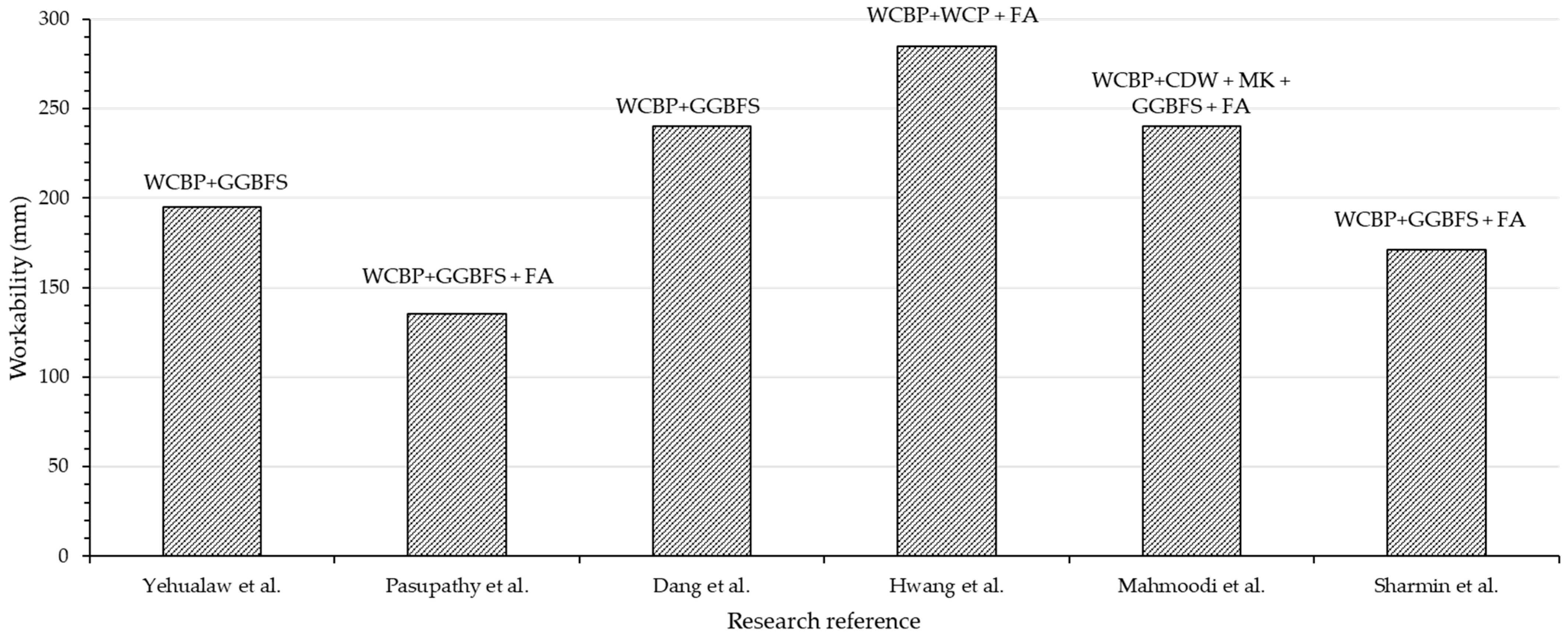
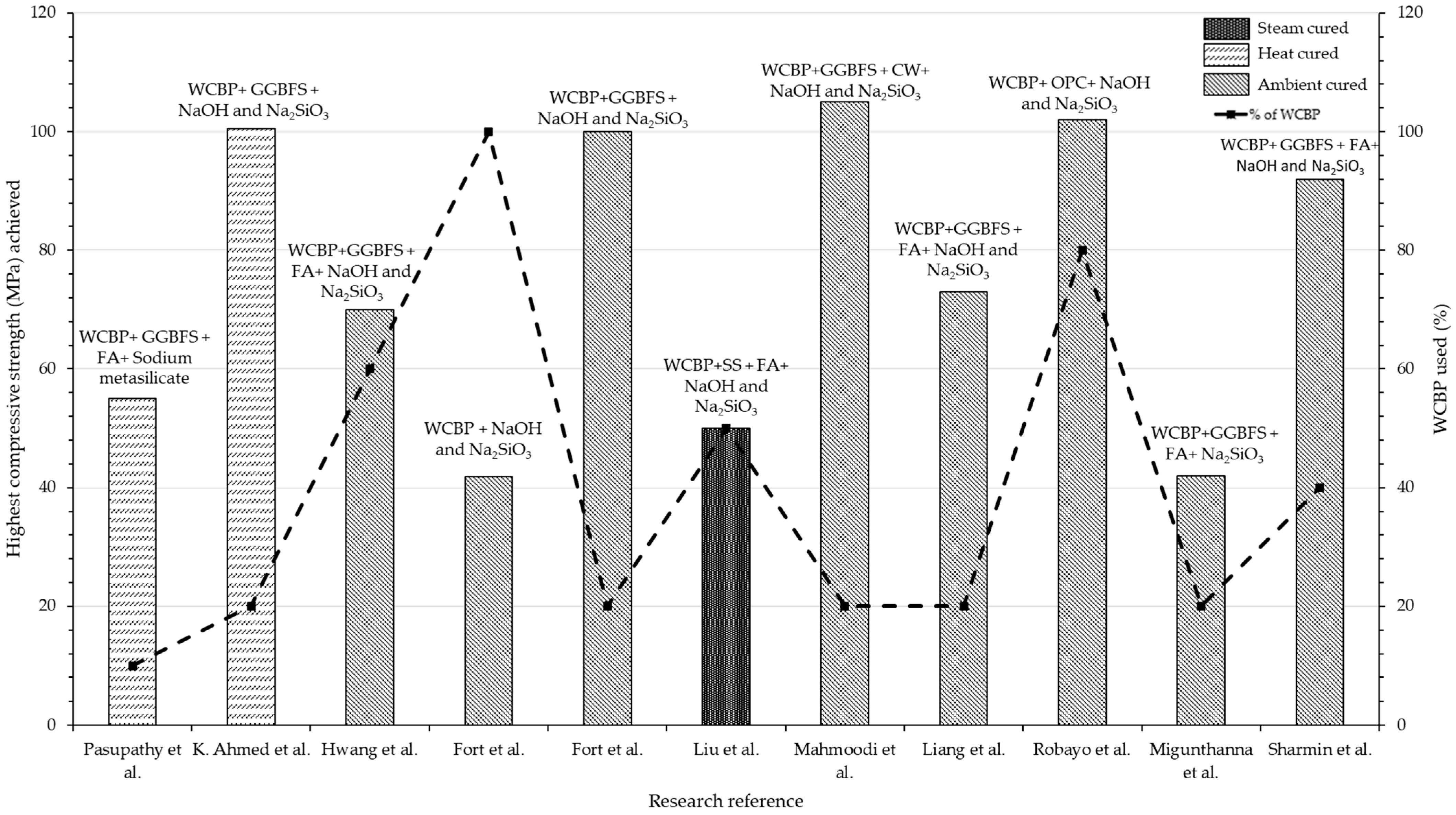

| Research Reference | Durability Related Investigation Performed |
|---|---|
| D’Angelo et al. [63] | Water absorption. |
| Migunthanna et al. [29] | Water Absorption, absorption and volume of permeable voids, performance after long-term immersion in water, resistance to sulfate attack, cyclic wetting and drying, abrasion. |
| Vafaei et al. [70] | Changes in compressive strength and mass exposure to H2SO4 and HCl. |
| Wong et al. [71] | Water absorption, sorptivity. |
| Alzeebaree et al. [46] | Sorptivity, water absorption. |
| Ahmed et al. [67] | Drying shrinkage, water absorption. |
| Al-Noaimat et al. [58] | Water absorption, freeze–thaw resistance, fire resistance. |
| Vidak et al. [82] | Water absorption. |
| Li et al. [64] | Water absorption. |
| Komnitsas et al. [50] | Freeze–thaw resistance. |
| Research Reference | Sustainability Related Investigation | Major Outcome |
|---|---|---|
| Pasupathy et al. [43] | CO2-e emission and energy consumption analysis | GC showed a 60–80% reduction in both embodied energy and carbon footprint compared to OPC. |
| Robayo-Salazar et al. [81] | LCA | NaOH and Na2SiO3 exhibit higher CO2 emissions but superior mechanical performance, whereas Na2CO3 and Na2SO4 emit less CO2 but offer lower mechanical performance. |
| Kul et al. [75] | LCA | NaOH and grinding of CDW-based precursors had the largest environmental impact in LCA analyses, followed by transportation and heat curing. |
| Mahmoodi et al. [34] | CO2-e emission and energy consumption analysis | Ternary geopolymer reduced energy and CO2 compared to OPC and mono-based. |
| Cong et al. [44] | Environmental and life cycle cost analysis | BP-based alkali-activated materials reduced energy consumption by 97% and GHG emissions by 53% compared to OPC. |
| Li et al. [64] | CO2-e emission and energy consumption analysis | BP-based geopolymers reduce CO2 emissions by 40%–70% and energy consumption by 20%–50% compared to OPC. |
| Mir et al. [85] | LCA | GWP values for industrial large-scale scenarios are 25% lower than those for small-scale laboratory scenarios. |
| Liang et al. [52] | LCA | Using BP in geopolymers reduced CO2 emissions by 70% and energy consumption by 54%. |
| Migunthanna et al. [31] | LCA | Na2SiO3 exhibited the highest CO2 emissions (1477 kg/t) and energy consumption (4860 MJ/t), surpassing that of OPC. |
| Fort et al. [24] | CO2-e emission and energy consumption analysis | The embodied energy analysis highlights the significant impact of alkaline activators. |
| Sharmin et al. [6] | Techno-echo-efficiency analysis | Energy used in alkaline activator production at the batching plant emerged as a significant factor, followed by waste brick grinding. |
Disclaimer/Publisher’s Note: The statements, opinions and data contained in all publications are solely those of the individual author(s) and contributor(s) and not of MDPI and/or the editor(s). MDPI and/or the editor(s) disclaim responsibility for any injury to people or property resulting from any ideas, methods, instructions or products referred to in the content. |
© 2024 by the authors. Licensee MDPI, Basel, Switzerland. This article is an open access article distributed under the terms and conditions of the Creative Commons Attribution (CC BY) license (https://creativecommons.org/licenses/by/4.0/).
Share and Cite
Sharmin, S.; Biswas, W.K.; Sarker, P.K. Exploring the Potential of Using Waste Clay Brick Powder in Geopolymer Applications: A Comprehensive Review. Buildings 2024, 14, 2317. https://doi.org/10.3390/buildings14082317
Sharmin S, Biswas WK, Sarker PK. Exploring the Potential of Using Waste Clay Brick Powder in Geopolymer Applications: A Comprehensive Review. Buildings. 2024; 14(8):2317. https://doi.org/10.3390/buildings14082317
Chicago/Turabian StyleSharmin, Shaila, Wahidul K. Biswas, and Prabir K. Sarker. 2024. "Exploring the Potential of Using Waste Clay Brick Powder in Geopolymer Applications: A Comprehensive Review" Buildings 14, no. 8: 2317. https://doi.org/10.3390/buildings14082317







